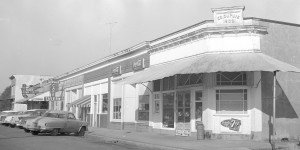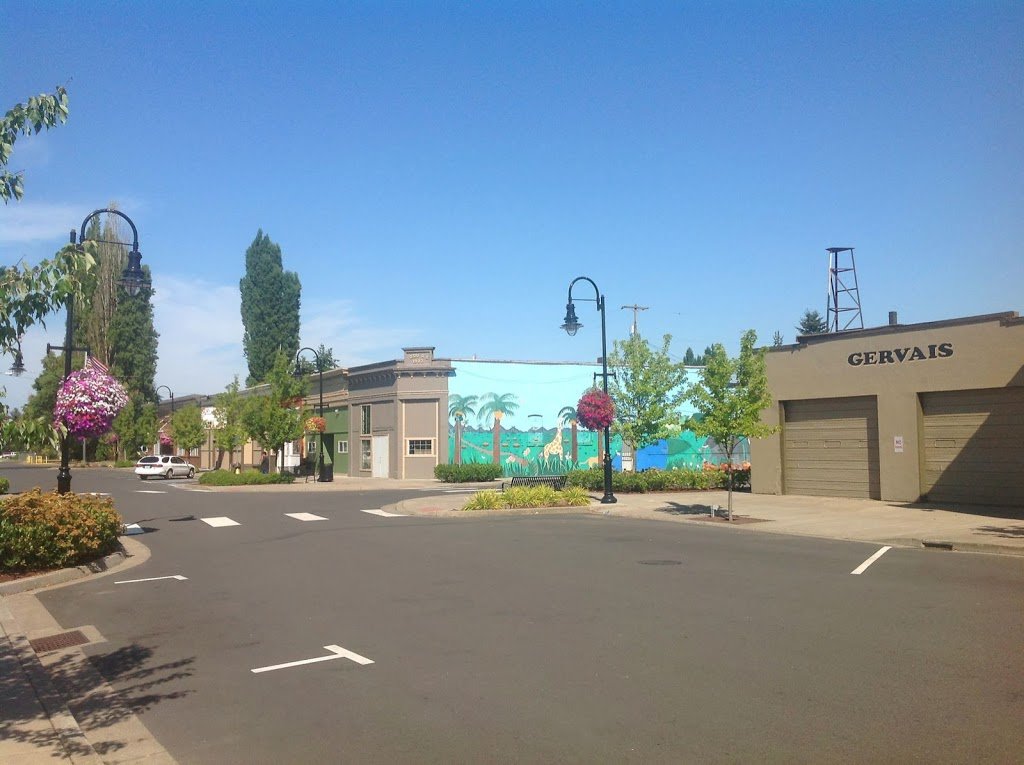 |
| Gervais in 1961 |
The mayors of Marion County cities are elected, but unpaid, officers in their communities. Their time is divided. Of the few we met, the one who responded to our project with the most enthusiasm was Shanti Platt. Our first task was to share what we each knew of the city’s heritage, resulting in the following historical outline.
The city is named for John Joseph Gervais, a French Canadian settler of the Willamette Valley. (the name has been anglisized from the original French “Gervai” to the English “Jervis”.) He came to Oregon in 1811 in the Hunt party of Jacob Astor and for a number of years was a fur trapper under protection of the British Hudson’s Bay Company. He settled on French Prairie and his farm has become a footnote in Marion County history. In 1834, Jason Lee camped there and declared the melons to be the finest he had ever tasted. Lee observed Solomon H. Smith, Gervais’ brother-in-law, teaching children of the French trappers ~ the first school in the Willamette Valley. This may have been the inspiration for the Indian Manual School of Lee’s own mission settlement. Gervais, along with the majority of French Canadians at Champoeg in 1843, is believed to have voted to keep the Oregon Country under British rule during the meetings that led to an American provisional government in the Oregon Country.
Reverend Neill Johnson of the Cumberland Presbyterian Church is said to have suggested giving his name to the new 1870 railroad depot in an already twenty-year old community founded by Samuel Brown. Brown purchased two Land Grant properties and by 1858 had built a fine house for his family, which grew to 13 children. The house was a stop for the stagecoach line through Marion County. With the railroad passing through his property, Brown and a neighbor, John Thornbury, laid out a town plot of 100 acres, with every other block donated to the railroad. Merchants were attracted to the town and the rapid growth led to the formation of a town council and recognition by the state legislature that approved its incorporation in 1878. By this time there were both a Catholic and Baptist church, school, hotel, storage warehouses for grain and several lodges; Masonic, Odd Fellows and Good Templars. Two civic problems were downtown flooding, partially solved with ditching and raised plank sidewalks, and fire. A water tower and tank were constructed. Unfortunately, on October 6, 1902, the business district of the city burned and losses were estimated at $100,000. The local fire department’s power was insufficient to handle the blaze with both Portland and Salem fire departments being called to assist. Unfortunately, they were unable to respond in time to help. In little over an hour all but two businesses had burned to the ground. According to a Salem Capitol Journal news report of the time, fire broke out at 10:30 a. m. in the rear of Thompson’s confectionary and destroyed 23 businesses and structures before it burned itself out. The town’s water tower ignited and crashed early in the fire. Only an antiquated hand pumper remained for combating the conflagration. [This hand pumper is now displayed in the City Hall lobby.] All three of the city’s saloons were burned. However, one saloonkeeper set up bar in a barn that escaped the flames. He was dispensing liquor again before the ruins of his former place ceased to smolder. (See Ben Maxwell’s Salem, Oregon, edited by Scott McArthur, 2006)
The town was rebuilt in brick, furnished with concrete sidewalks, and was once again a good place for French Prairie citizens to shop and trade. Automobiles appeared causing some amusement for those who thought them a passing fancy. The well-managed Gervais State Bank survived the Depression. During World War II, the trains pausing in town with military recruits were greeted by the residents and often these chance encounters led to friendships. After the war, as housing construction boomed, the Gervais Limber Company prospered. It was not until the 1960s, when worldwide competition in industry and marketing began to give small town Americans wider choice in employment and services that Gervais declined in business prosperity.
Shanti acquainted us with the facts of the city today, less than one-half square mile in size with a population of about 2,550 residents. Prosperous farms and nurseries surround the 800 households of the city. Local schools are important to the residents who recognize the importance of the classroom education for young citizens. She pointed out the city website that identifies the city staff, names the businesses that contribute and enhance the city’s sustainability and offers local photographs.
The next step in our learning about Gervais was her generous offer of a city tour. With the mayor as our guide, we began by walking around the blocks of downtown, noting the historic houses and stopping in the Gervais Telephone Company at 489 3rd Street. Among the displays is a 1938 switchboard that was the communication hub of the Gervais area. Each manual plug connected a customer to neighbors (and to the other “party-line” customers!)
Then, with Tom behind the wheel and Shanti as navigator, we began a wider tour, first visiting the Elm Street Park and the old, one-room jail. Heading out of town, we passed near the National Register Sam Brown House at 12878 Portland Road NE, standing near the intersection of Pacific Highway and Mt. Angel Road. At Howell Prairie Road, we turned south and left at Waconda Road to see the former residence of Gov. Snell. In the center of the wide lawn before the house, there is a towering, ancient tree: this is traditionally a place where the Indians gathered to trade with the pioneer French Canadian trappers. When we assured her that we were interested in seeing the Old Believer Russian Community, we turned back onto Howell Prairie Road and north to Monitor McKee Road. On Frolov Drive we saw the first Russian structure and glimpsed golden domes in the distance. Shanti directed us to Bethlehem Drive where we were amazed to see a beautiful church with the golden domes associated with Russian churches. After we returned to City Hall to let the mayor get back to her municipal duties, we drove to 7th Street and Douglas Avenue to see Gervais’ Sacred Heart Parish established in 1875.
On our way home, we reflected on our one day-trip with such an international favor, past and present. As the community began with settlers of different cultural background, Gervais continues the tradition of ethnic acceptance with both Russian and Hispanic residents working in both local and regional agricultural enterprises. It is appropriate that this historic area of Oregon, settled by French-Canadians before the arrival of the American missionaries, would continue to be hospitable to a population made up of diverse cultures.
Of course, the contemporary life of North Marion County is not neglected. Gervais sits along 99E, within five miles of Woodburn and Mt. Angel; Keizer is only a distance of 10 miles. It is a quiet, peaceful community with a tradition of welcome.
One afternoon offers only a sample of Gervais attractions. Annual events include
April ~ Annual Earth Day/SOLV Clean-up is a citywide activity organized with the cooperation of Allied Waste.
May ~ Aquilar de Oro ~ Cinco de Mayo
July ~ Independence Day Celebration is held on Main Street
September ~ “Joy of Art” Chalk Festival sponsored by the Gervais Telephone Company
October ~ Haunting in the Corn, Wooden Shoe Corn Field in Woodburn
December ~ Community Holiday Festivities and Bazaar
Each Tuesday, after a city was featured in that Sunday’s Statesman Journal, KMUZ broadcasted “Marion County 20”. To learn more about Gervais, listen to the podcast as listed on the KMUZ archives.

